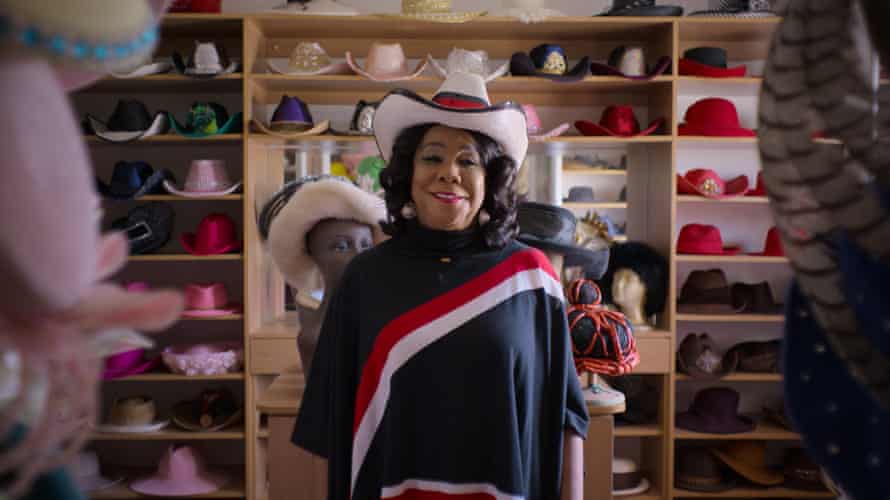I am not a minimalist: I don’t want to live with extreme amounts of nothing. I like “things”, and I like my things, which means I have several boxes of clothes, bags and shoes in my possession that have accompanied me through the best part of two decades. One of the boxes is my best and largest suitcase. When I was still travelling fairly regularly, I would have to empty out the contents of the suitcase and pile them somewhere else for my return, a process that feels a bit like uncovering memories and repressing them again, two weeks later, with a zip that goes all the way around.
Given the displacement of a series of house moves in my earlier 20s, the fact that I even still possess the navy corduroy American Apparel hotpants I wore to go clubbing at university (now, for users of the fashion app Depop, a vintage item), or the 70s-era yellow, white and purple-striped T-shirt I was wearing when I had an encounter with the far more colourful Iris Apfel, the interior designer, feels nothing short of miraculous. Today, I can recite what I was wearing to interview various figures in my former role as an editor at a fashion magazine, outfits carefully planned though liable to go awry, like when the zip on my green, chequered skirt broke off while meeting Chloë Sevigny.

Netflix’s new series Worn Stories is all about this very theme: the stories behind the items of clothing we hold dear. It’s not about following fashion, but rather our clothes, and what they mean to us. This is not a new idea: book projects exploring how clothing shapes our lives have been bestsellers in recent years, such as 2014’s Women in Clothes, by Sheila Heti, Leanne Shapton and Heidi Julavits, or the book series (Worn Stories in 2014 and Worn in New York in 2017) by Emily Spivack from which the Netflix show was developed. In the introduction to her first book, Spivack explicitly positions her wardrobe as more than just storage for clothes: it is, for her, “an evolving archive of experiences, adventures, and memories”.
The eight half-hour episodes of Worn Stories bring this way of thinking about, and through, clothing into the TV landscape. The treatment of the narratives gathered here is tender: each episode, structured thematically (“Community”, “Lost and Found” and – yes – “Love”), contains stories of discovery, loss and self-actualisation connected to specifc items of clothing, from a Berlin-sourced leather codpiece to the first items in a post-prison wardrobe. A series of interviews to camera, the show sews these testimonies together with trips to places such as a gigantic Las Vegas dry cleaners, or a centre for Korean pensioners in Queens, New York. And, other than appearances by famous figures of old such as the Spanish American glamazon Charo and Tim “Sexy Sax Man” Cappello, the tales are told by a diverse bunch of figures of all ages, lifestyles, backgrounds and fashion senses (a nice expansion of the books, which felt a little too New York media at times in their selection).

Unlike plants, sponge cakes, or ceramics, this was the first time that I had seen ordinary pieces of clothing treated so reverently on screen. Together, these stories throw a new idea into the much-eyeballed world of Netflix. That is: maybe clothing is about more than self-improvement or status. In this way it feels, for me, like a riposte to a recent trend in television that encouraged us to get rid, in order to let go, of the past: from the extremes of Marie Kondo’s tidying up, to the self-development narratives of Queer Eye, to the archaic focus on preying on women’s insecurities (see: Trinny and Susannah’s What Not to Wear). The latter’s insult-laden narratives are best left in the body image-obsessed early 2000s. But maybe, one year into a period of sitting at home surrounded by everything of our past, 2021 is an opportunity for a different kind of storytelling around clothes: less, “Deleting my past to become a better me”, more, “I am who I am, and these are the things that have shaped me.”
Still, I couldn’t help but feel it was all a little too neatly tied together. Though Worn Stories offers colourful tales, the question remains: why do our memories stick to the clothes we wear so strongly over other objects? Besides, there is something inscrutable in clothing, something magical that is often hard to articulate. This also frustrated Virginia Woolf, who wrote about it in her diary in 1925: “My love of clothes interests me profoundly, only it is not love; and what it is I must discover.” There’s a feeling, with Worn Stories’ misty-lensed closeups of garments, its Edward Scissorhands-style score and animated segments, of a kind of visual straining at this same inarticulable thing.
It’s difficult to translate what clothing really means to us to the small screen. But has anyone really tried before? Its tactility, emotional life and worn-ness feels as if it has been more successfully captured in cinema: from Peter Strickland’s blackly comic horror In Fabric – about a dress that plagues its owners – to Sofia Coppola’s The Virgin Suicides, with its 70s prairie aesthetic, or the taffeta gowns and ironed shirt-cuffs of Paul Thomas Anderson’s Phantom Thread. All of these films understand that clothes, with the mysteries they hold, are just one type of material for telling stories about living. And, as such, are worth holding on to.
Underneath the affectionate closeups and swelling music, it feels as if Worn Stories understands this, too. For memory hoarders like me who continue to resist the life-changing magic of tidying up, the series feels like an important addition to that canon. As lockdown boils our wardrobes down to their most essential contents, maybe my old hot pants deserve a different kind of respect, too.

